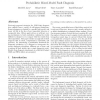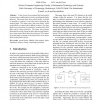ITC
1998
IEEE
14 years 4 months ago
1998
IEEE
Previously-proposed strategies for VLSI fault diagnosis have su ered from a variety of self-imposed limitations. Some techniques are limited to a speci c fault model, and many wil...
ICCAD
1999
IEEE
14 years 4 months ago
1999
IEEE
In this paper we present new methods for fast justification and propagation in the implication graph (IG) which is the core data structure of our SAT based implication engine. As ...
ATS
2000
IEEE
14 years 4 months ago
2000
IEEE
: In this paper a complete analysis of spot defects in industrial SRAMs will be presented. All possible defects are simulated, and the resulting electrical faults are transformed i...
SAFECOMP
2001
Springer
14 years 4 months ago
2001
Springer
This paper focuses on the development of a conceptual framework for integrating fault injection mechanisms into the RDD-100 tool2 to support the dependability analysis of computer...
DATE
2002
IEEE
14 years 5 months ago
2002
IEEE
: It has always been assumed that fault models in memories are sufficiently precise for specifying the faulty behavior. This means that, given a fault model, it should be possible...
DATE
2006
IEEE
14 years 6 months ago
2006
IEEE
— We present a probabilistic fault model that allows any number of gates in an integrated circuit to fail probabilistically. Tests for this fault model, determined using the theo...
DATE
2006
IEEE
14 years 6 months ago
2006
IEEE
Abstract: DRAMs play an important role in the semiconductor industry, due to their highly dense layout and their low price per bit. This paper presents the first framework of faul...
ETS
2007
IEEE
14 years 6 months ago
2007
IEEE
This paper summarizes advanced test patterns designed to target dynamic and time-related faults caused by new defect mechanisms in deep-submicron memory technologies. Such tests a...
ASPDAC
2009
ACM
14 years 6 months ago
2009
ACM
Low power circuits have become a necessary part in modern designs. Retention flip-flop is one of the most important components in low power designs. Conventional test methodologie...



